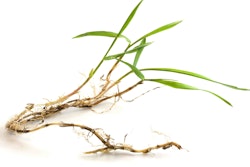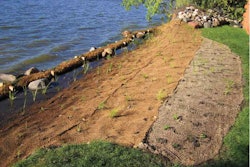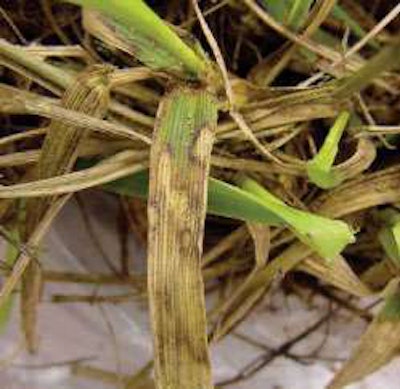
Here are the most effective ways to prevent and treat this difficult turf disease.
In the summer, humidity and excessively wet conditions can create the perfect opportunity for brown patch.
“Heavy rainfall, too much irrigation, wet and humid sites, poorly drained areas, long periods of wet foliage, wet thatch and damp soils are the main factors,” says Joseph Rimelspach, program specialist, plant pathology, at Ohio State University.
Here’s Rimelspach’s best “turf doctor” counsel to help you identify and treat brown patch or, during a good year, prevent it.
The disease
Brown patch or Rhizoctonia blight
Cause/Pathogen
The fungus Rhizoctonia solani
Grasses at risk
+ All common turfgrasses
+ Especially lush, cool-season grasses
+ Tall fescue lawns
Environmental influences
+ Hot, wet and humid weather patterns
+ Daytime temperatures 80 to mid 90s
+ Nighttime temperatures warm, mid 60s and above
+ Abundant rainfall
Areas of increased susceptibility
+ Overly irrigated sites
+ Wet soils and poor drainage
+ Shaded lawn areas
+ Lawn areas with little to no air movement
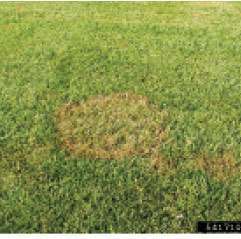 Be on the lookout for the beginning stages of brown patch, which appears just like its namesake.
Be on the lookout for the beginning stages of brown patch, which appears just like its namesake.Symptoms
+ Irregular to circular patches (6 inches to 2 feet in diameter)
+ Patches variable shades of tan to brown
+ Outer edges of patch may be darker
+ Irregularly shaped dark lesions on leaves
+ Gray to white fungal growth when turf is wet and during high humidity (may be seen in the early morning with dew)
Diagnosis
“There are many challenges to accurately diagnosing brown grass in lawns,” Rimelspach says. “Since all common turfgrasses can get brown patch, it is difficult to rule out the disease on the basis of the type of grass in the lawn.”
If there are brown patches in a lawn and the turf and site are dry, brown patch is most likely not the problem, he says. Not sure? Sample turf and send it to a lab for testing. It’s the safest way to get an accurate diagnosis.
Most extension agencies will charge from $20 to $75 for disease identification, and some universities charge $100 to $150, depending on whether you want a phone consultation or a written report of their findings. Turnaround time varies from one day to several weeks, depending on the disease, but is typically around three days.
Doctor’s orders
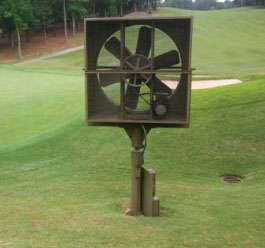 Increased airflow can help prevent the disease. For lawns: remove obstructions such as overgrown trees and shrubs.
Increased airflow can help prevent the disease. For lawns: remove obstructions such as overgrown trees and shrubs.+ Avoid excessive fertilizer, especially in summer. Several light fertilizer applications are less likely to trigger disease than one heavy application, Rimelspach says.
+ Keep grass as dry as possible.
+ Mow lawns and avoid excessively tall grass.
+ Improve airflow over the lawn by removing obstructions, like overgrown shrubs and trees. For golf courses, fans are sometimes used.
+ Avoid over-watering. Rimelspach recommends deep, infrequent irrigation early in the day, which gives turf leaves a chance to dry quicker.
+ Select genetically resistant grass cultivars, such as Wolfpack II, Hemi, Shenandoah Elite, Talladega and Turbo.
+ The National Turfgrass Evaluation Program offers information on turfgrass assessment for disease. Check it out online at www.ntep.org.
Prescription
+ Dozens of products and more than 30 active ingredients are labeled for preventive and/ or curative control of brown patch.
Hot and humid weather increase the growth of brown patch.
Rimelspach suggests trying fungicides in the strobilurin family, such as Compas (trifloxys- trobin), Disarm (fluoxastrobin), Heritage (azoxystrobin) and Insignia (pyraclostrobin), which are effective against brown patch (always check labels for use restrictions).
+ Often, the disease will subside when weather conditions are cooler and dryer.
Pre-existing condition
When a lawn has had previous brown patch problems, Rimelspach recommends you apply fungicides when humid weather and hot nights are predicted.
Applications should continue according to the fungicide label for as long as the hot, humid weather persists. Understanding the causes and taking the correct actions can help end and prevent brown patch turf disease.
EDITOR’S NOTE: This article was written by Cindy Ratcliff.

